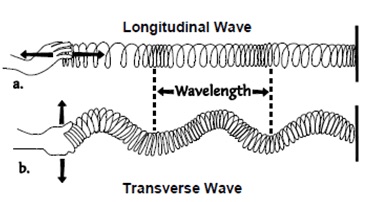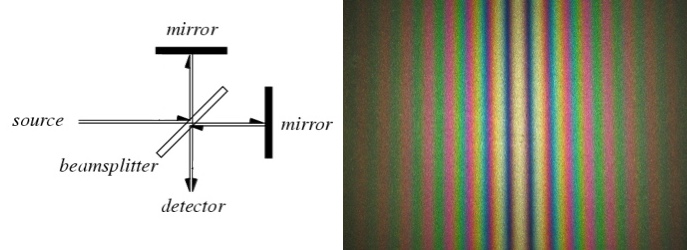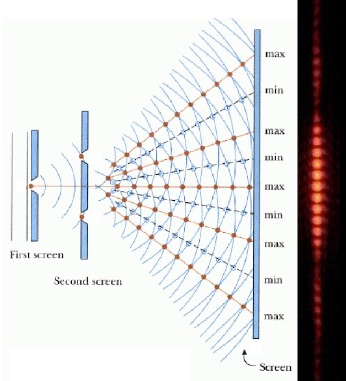Physicist: In short: nothing. Light acts like a wave, but unlike sound waves, light isn’t a material that’s moving back-and-forth.
Waves are a coordinated movement of atoms. A wave itself isn’t made of anything, it’s just a propagating motion through a material. Each part of the medium more or less stays where it is, but passes the movement of the wave to nearby material.

A wave is a coordinated movement that passes through a medium, generally without the medium itself moving very far.
For example, sound manages to move get from whatever-that-was-just-now to your ear at about 0.2 miles per second. At yet, the air around you doesn’t noticeably move anywhere when sound moves through it. Sound is literally just atoms in air smacking into other atoms, making those freshly smacked atoms move a tiny distance to smack into another set of atoms, and so on.
While waves take several different forms, the basic idea is always the same: waves are tiny movements that propagate from place to place inside of a host material. Sound is waves in air, ripples are waves in water, earthquakes are waves in the ground; every wave seems to need some material to do the waving.
A few centuries ago, Thomas Young proved that light is definitely a wave by demonstrating that it is capable of interference. In so doing he also managed to measure the wavelength of visible light: 400nm for purple to 700nm for red. Technically, what Young did was demonstrate that, whatever light it is, has wave-like properties. At the time, everything that was known to be wave-like was in fact a wave. So Young’s experiment led to the completely natural, titular question of this post: if light is a wave, then what’s doing the waving?
Physicists, never shy to name things they’re pretty sure exists, declared that the material light moves through is the Luminiferous Aether (“luminous” for “light” and “aether” for “I don’t know what it is either”).
Typically, when you can hear, you can breathe, and when you can be pushed by an ocean wave, you’re already wet. Because we can see, we must be immersed in the Luminiferous Aether (otherwise, how does the light get to our eyes?). It would seem that one of the important properties of the Aether is that you can’t feel it, see it, or smell it.
One of the first experiments concerning the Aether was to evacuate (pull all the air out of) a glass jar and look through it. Turns out: light doesn’t need anything made of matter to move through. The Aether must be fill the universe and pass freely through every material thing. And since we can see stars just as clearly in every direction, it must fill the universe in a very smooth and uniform way. Strange stuff.
There is a long history of debate over why the Aether does or doesn’t exist. It doesn’t. Here’s a very brief thread of the debate that more or less gets to (one of) the heart(s) of the issue.
The fact that light has polarization means that it is a transverse wave (side/side), but only longitudinal waves (forward/back) can exist in a gas or liquid.

a: Longitudinal waves can exist in gases. b: Both longitudinal and transverse waves exist in solids.
That implies that the Aether must be a solid that permeates all of space. But here’s the thing: Earth moves. More than that, it moves in big circles, so for most (if not all) of the year it must be moving relative to the Aether. That movement is detectable.
If you drop pebbles off of a moving boat, you’ll notice that the ripples moving toward the front of the boat move slower and the ripples moving toward the back move faster (from your boat-bound perspective). If you bounce waves back and forth in a moving medium you find that they go faster in one way and slower in the other and that overall the slow part “wins”; waves always take longer to go out and come back in a moving medium. So bouncing waves back and forth is a good way to tell if you’re moving and even how fast.
Enter Michelson-Morley. In the late 19th century they created an interferometer which bounced light back and forth in two directions and then compared the two paths. Any discrepancy in the direction or speed of the waves in either direction is immediately detectable. I’m mean, you can’t even breathe near these things without sending the interference pattern into convulsions. In fact, interferometers are so sensitive that they’re used to detect gravity waves (which are a really, really… really tiny effect).

Left: In an interferometer light is bounced along two paths and recombined. Right: The combined light interferes creating an interference pattern. These are infamously sensitive to even tiny changes.
But no matter how Michelson and Morley aligned their apparatus, and no matter how it was moving, the results were always exactly consistent with zero movement of the Aether. So assuming it exists, the Aether must be solid and it must be stationary with respect to the Earth. This spawned a whole string of weird theories, like that the Aether is mostly solid but also sticks to the Earth as it moves. These new theories have since been ruled out one by one. For example, if the Earth did have a blob of Aether stuck to it, the “shear boundary” between the Earth’s moving patch of Aether and the differently moving Aether of deep space should have made stars appear to move throughout the year. But they don’t.
Following light, we found that every other kind of quantum wave (there’s one for every different kind of particle), has wave-like properties but no medium. For example, electrons are also waves and they also don’t need a medium to move through (they move through deep space all the time). These mediumless-waves are distinct from the waves we’re usually talking about when we say “wave” (like sound and ripples). We need a new word for mediumless-waves to distinguish them from mediumful-waves. “Evaw” maybe? Or… anything other than Evaw.








38 Responses to Q: If light is a wave, then what’s doing the waving?